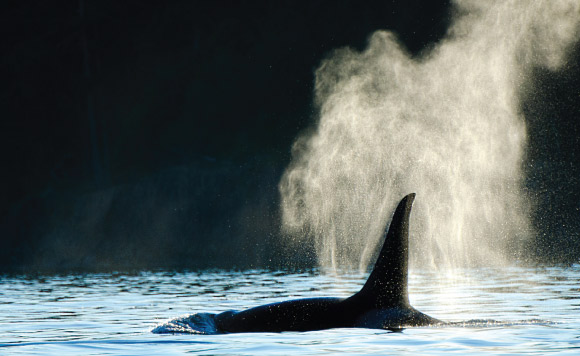– by Tina Kelly –
Catchy jingles, alliteration or memorable slogans help ideas stick. In January’s Salish Sea News, “Lose the Loop” was the one to learn. This month, the Marine Education & Research Society’s (MERS) “See a Blow? Go Slow!” is the phrase to remember. MERS’s newest campaign aims to bring awareness of vessel strikes on whales.
Historically, commercial whaling decimated populations of large baleen whales and humpback whales were no exception. In 1966, whaling was banned but humpback populations were slow to recover, until now. Dubbed the “Humpback Comeback”, humpback whale sightings have increased and researchers estimate that the population is increasing by 4.9-6.8% per year. With warmer weather just around the corner, boat traffic will also increase. Pleasure boaters, tourism vessels, and cruise ships will join an already busy freighter route.
Motor vessels and large whales sharing the same space doesn’t always equate to the magical wildlife encounters worthy of tourism commercials. In the spring of 2013, a Vancouver Island man required more than $10,000 worth of reconstructive facial surgery and dental work after a humpback whale breached on to his pleasure craft. A breaching whale launches at least 40% of its 40 tonne body out of the water. Jackie Hildering, MERS Education Director, stresses the importance of educating boaters about not only the increase in whale numbers, but also the unpredictability of whale movements, surfacing patterns and breaching behaviour.
In order to avoid contact or collision with whales, MERS “See a Blow? Go Slow!” initiative encourages boaters – along the entire coast of BC – to adapt their own behaviour by following these guidelines:
• Always be on the lookout for blows – the misty air and vapour exhaled from a whale’s blowhole when coming to the surface to breathe
• Watch for vessels flying the “Whale Watch Flag”; this signals that whales are nearby
• Be alert for, and stay away from, large aggregations of birds (whales feed on the same schooling fish birds target)
• Slow down to 7 knots when a blow is spotted
• Do not approach within 100m of a whale and maintain 100 – 400m distance
• Increase vigilance in areas with known whale activity
While facial surgery was required for the island man, injuries sustained by the whale were not determined. Vessel strikes are rarely reported and Hildering acknowledges that, “this is one of the barriers we would like to break down. If boaters report involvement in, or witnessing, a collision, we will be better able to understand and mitigate the risk of a vessel strikes.” To report a collision between a boat and a whale, call the DFO Incident Reporting Hotline at 1.800.465.4335.
For more information on this campaign, MERS, and humpback whales, visit merssociety.org.




